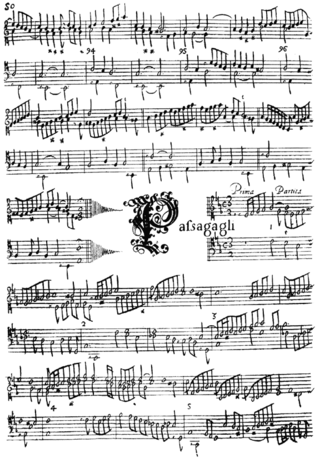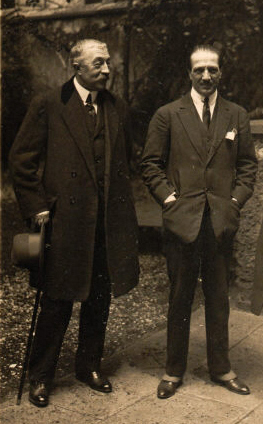
A chaconne is a type of musical composition often used as a vehicle for variation on a repeated short harmonic progression, often involving a fairly short repetitive bass-line which offers a compositional outline for variation, decoration, figuration and melodic invention. In this it closely resembles the passacaglia. It originates and was particularly popular in the Baroque era; a large number of Chaconnes exist from the 17th- and 18th- centuries.

The passacaglia is a musical form that originated in early seventeenth-century Spain and is still used today by composers. It is usually of a serious character and is typically based on a bass-ostinato and written in triple metre.

Music for Strings, Percussion and Celesta, Sz. 106, BB 114 is one of the best-known compositions by the Hungarian composer Béla Bartók. Commissioned by Paul Sacher to celebrate the tenth anniversary of the chamber orchestra Basler Kammerorchester, the score is dated September 7, 1936.

Joseph Haydn's Symphony No. 13 in D major was written in 1763 for the orchestra of Haydn's patron, Prince Nikolaus Esterházy, in Eisenstadt.
In music, variation is a formal technique where material is repeated in an altered form. The changes may involve melody, rhythm, harmony, counterpoint, timbre, orchestration or any combination of these.
The Cello Concerto in A minor, Op. 129, by Robert Schumann was completed in a period of only two weeks, between 10 October and 24 October 1850, shortly after Schumann became the music director at Düsseldorf.

Per Nørgård is a Danish composer and music theorist. Though his style has varied considerably throughout his career, his music has often included repeatedly evolving melodies—such as the infinity series—in the vein of Jean Sibelius, and a perspicuous focus on lyricism. Reflecting on this, the composer Julian Anderson described his style as "one of the most personal in contemporary music". Nørgård has received several awards, including the 2016 Ernst von Siemens Music Prize.

The Symphony of Psalms is a choral symphony in three movements composed by Igor Stravinsky in 1930 during his neoclassical period. The work was commissioned by Serge Koussevitzky to celebrate the 50th anniversary of the Boston Symphony Orchestra. The symphony derives its name from the use of Psalm texts in the choral parts.

Pierre Eugène Onfroy de Bréville was a French composer.

David Matthews is an English composer of mainly orchestral, chamber, vocal and piano works.
Boris Ivanovich Tishchenko was a Russian and Soviet composer and pianist.
Jeffrey Ching is a contemporary classical composer. He was born in the Philippines, to Chinese parents. He is married with the operatic soprano Andión Fernández and has two children.
Souvenir des Ming is the title of Jeffrey Ching's Fourth Symphony, which was composed in London between 14 January and 29 June 2002, and is in a single large movement lasting about thirty-five minutes. There is a further parenthetical title, Passacaglia and Fugue on Ming dynasty Fragments, which describes the actual thematic content and form of the work. In China the work is known as Minglü huiyin 明律回音.
Kunstkabinett, a German term for a cabinet of curiosities, is a chamber work by the contemporary classical composer Jeffrey Ching. It was composed in Berlin on 05-28 June 2007, immediately after the completion of the first draft of the opera The Orphan, with which it shares both compositional approach and musical material. Like its much larger sibling, Ching's Symphony No. 5, "Kunstkammer" (2006), it is an assemblage of musical objets d'art not obviously related in any way except by the personal taste of their collector.
Rituals is the title of Jeffrey Ching's Third Symphony, a Philippine government commission for the centennial of the Philippine Declaration of Independence from Spain on 12 June 1898. It is in one continuous movement lasting about forty-four minutes. After weeks of planning and research, Ching began sketching it in London on 28 October 1997, completing the full score there on 19 May 1998. The world premiere was given in Manila on 14 June 1998 by the Philippine Philharmonic Orchestra under Josefino Toledo.
Concerto da camera is a composition for solo guitar, solo violoncello, soprano, and twenty strings, by the contemporary Chinese-British composer Jeffrey Ching.
Nazario Carlo Bellandi was an Italian music composer, organist, pianist, and harpsichordist.

Charles Clement Fussell is an American composer and conductor of contemporary classical music. He has composed six symphonies and three operas. His symphony Wilde for solo baritone and orchestra, based on the life of Oscar Wilde and premiered by the Newton Symphony Orchestra and the baritone Sanford Sylvan in 1990, was a finalist for the 1991 Pulitzer Prize for Music. He received a citation and award from the American Academy of Arts and Letters in 1992.








